Dujiangyan Scenic Area is located in the western part of Dujiangyan City, Chengdu, Sichuan Province. It is a World Cultural Heritage site, World Natural Heritage site, National Key Cultural Relics Protection Unit, and a national 5A-level tourist attraction. Covering an area of approximately 22,000 mu (about 1,467 hectares), it stands as the world’s most successful damless water diversion project with a history spanning over 2,000 years. To this day, it still fulfills its functions of flood control and irrigation, and has been instrumental in shaping the "Land of Abundance" (Tianfu Zhi Guo). The scenic area seamlessly integrates natural landscapes with cultural landscapes, demonstrating the remarkable achievements of ancient Chinese water conservancy projects and the unique water culture of China.
The Dujiangyan Water Conservancy Project mainly consists of three parts: the Fish Mouth (Yuzui), the Flying Sand Weir (Feisha Yan), and the Bottle-Neck Channel (Baopingkou). The Fish Mouth divides the Minjiang River into the Inner River and the Outer River. The Outer River is used for flood diversion, while the Inner River is for water diversion and irrigation. The Flying Sand Weir functions to discharge floods and flush out sand, and the Bottle-Neck Channel controls the water inflow of the Inner River.
History and Culture
The western Sichuan region features dramatic topographical changes. In ancient times, the Chengdu Plain was frequently hit by disasters such as floods, droughts, and waterlogging. After successive water control efforts by figures including the three kings and two emperors of the ancient Shu State, Yu the Great, and Bie Ling, Li Bing led people to construct the Dujiangyan Project. Since then, the Chengdu Plain has enjoyed stable livelihoods, prosperous people, and abundant supplies.
Dujiangyan nurtured the "Land of Abundance", promoted the unification of China by the Qin State, and indirectly influenced the historical process of the Chinese nation. It is known as the "originator of world water culture".
Adopting a damless water diversion approach, Dujiangyan adheres to the principle of "not opposing water" and utilizes natural forces for water diversion, distribution, flood discharge, sand flushing, and water intake. This embodies the concept of "following the laws of nature" (Dao Fa Zi Ran), which is not only a philosophical thought but also a practical guideline, exerting a profound influence on later generations.
In terms of management, through over 2,000 years of practice, Dujiangyan has gradually formed a three-level management system involving provincial governments, prefectural/county governments, and local communities. Its management institutions have been continuously improved, relevant laws and regulations have been refined, and the irrigated area and project benefits have been steadily expanded.
Main Attractions
Fulongguan (Fulong View)
Located in Lidui Park, Fulongguan is a temple built to commemorate Li Bing and his son. It houses a large number of cultural relics related to the Dujiangyan Water Conservancy Project, such as the stone statue of Li Bing dating back to the Eastern Han Dynasty. The buildings in the view are simple and elegant, boasting high historical and artistic value.
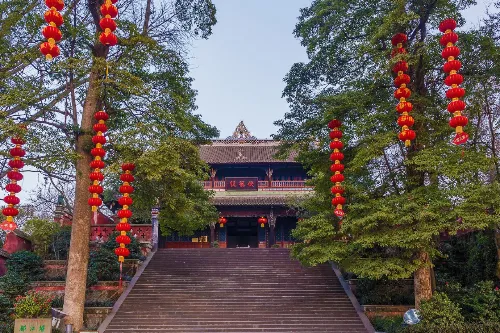
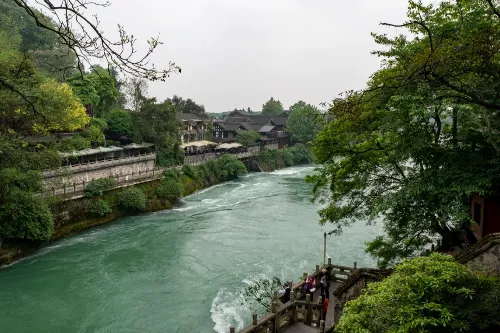
Anlan Cable Bridge
Also known as the "Couple’s Bridge", Anlan Cable Bridge spans both the Inner and Outer Rivers. It was an important commercial thoroughfare between western Sichuan and Aba Prefecture in ancient times. The bridge deck is suspended by thick bamboo cables stretched across the riverbanks, paved with wooden planks, and flanked by bamboo cables as handrails. Walking on it, you will feel a gentle sway, which is quite an interesting experience.
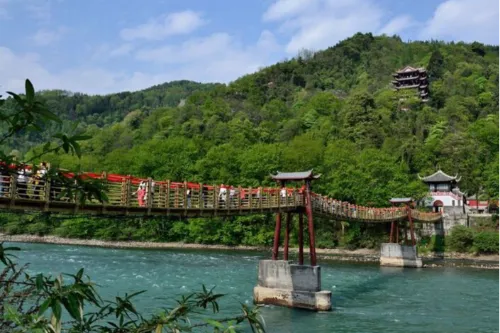

Qinyan Tower
Standing against the mountain and towering over the riverbank, Qinyan Tower features an exquisite structure and is one of the best spots to enjoy a panoramic view of Dujiangyan. Looking far into the distance, you can take in sights including the Fish Mouth, Anlan Cable Bridge, Erwang Temple, Yulei Pass, and the peaks of Qingcheng Mountain.
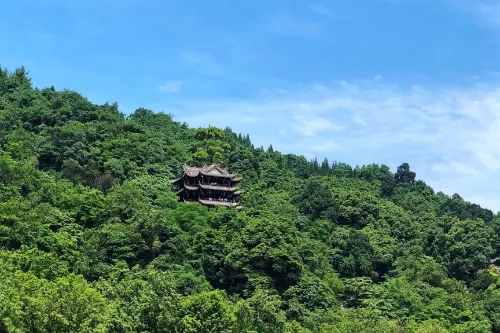

Erwang Temple
Erwang Temple is a grand temple built against the mountain to commemorate Li Bing and his son. Inside the temple, there are numerous stone inscriptions, plaques by celebrities of past dynasties, and murals depicting Li Bing and his son’s achievements in water control, all of which showcase rich water conservancy culture and historical connotations.
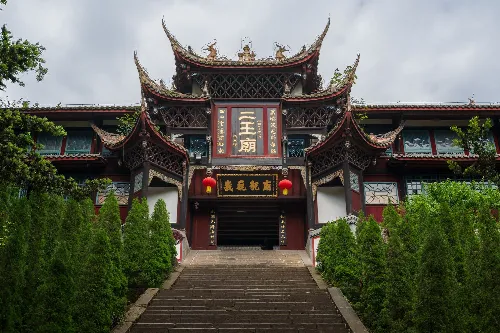
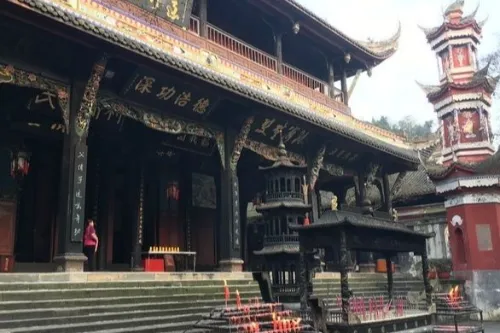
Fish Mouth (Yuzui)
As a key part of the Dujiangyan Water Conservancy Project, the Fish Mouth divides the Minjiang River into the Inner River and the Outer River, and its shape resembles a fish’s mouth. During the flood season, the Outer River diverts excess floodwater to protect the Chengdu Plain from flooding; during the dry season, the Inner River diverts water for irrigation to meet the water needs of farmland.
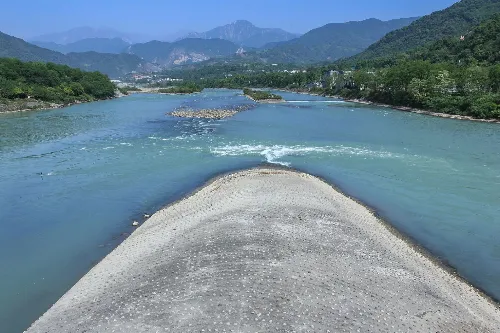
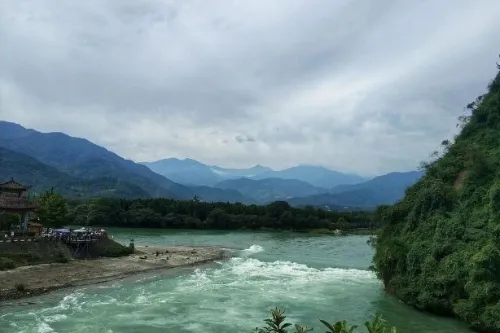
Flying Sand Weir (Feisha Yan)
Located between the Fish Mouth and the Bottle-Neck Channel, the Flying Sand Weir mainly functions to discharge floods and flush out sand. When the water volume in the Inner River exceeds the water intake capacity of the Bottle-Neck Channel, the excess water overflows from the Flying Sand Weir into the Outer River. At the same time, the weir uses the principle of meander circulation to flush sediment in the river into the Outer River, ensuring the smooth flow of the Inner River.

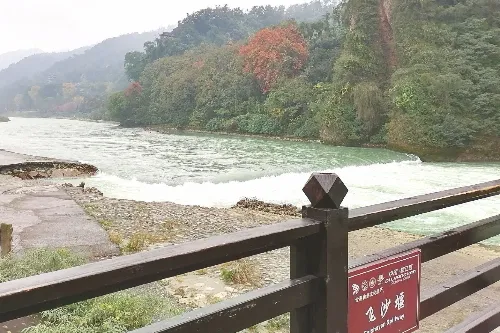
Bottle-Neck Channel (Baopingkou)
The Bottle-Neck Channel is a narrow opening excavated manually, which controls the water inflow of the Inner River and resembles the mouth of a bottle. Only through this channel can the water from the Inner River flow into the Chengdu Plain for irrigation. The cliffs on both sides of the channel are steep, making the project extremely difficult to construct—an embodiment of the wisdom and creativity of ancient working people.
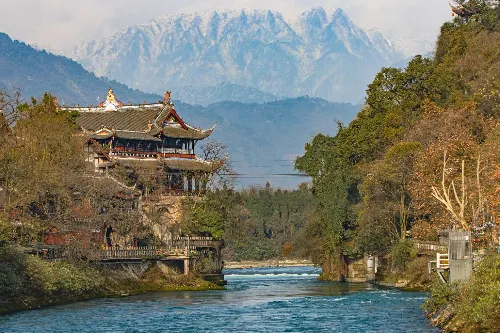
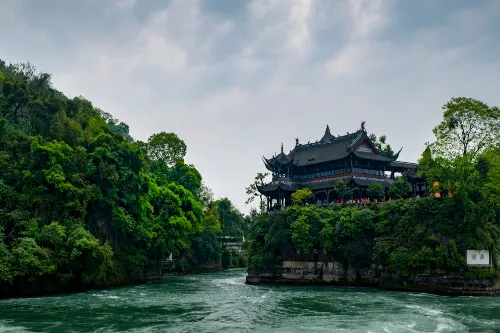
Qingxi Garden
Located in Lidui Ancient Garden within Dujiangyan Scenic Area, Qingxi Garden is a high-quality Sichuan-style bonsai garden covering an area of over 8,000 square meters. The garden buildings feature the style of western Sichuan dwellings, and traditional Chinese garden techniques such as framed scenery, obstructed scenery, and borrowed scenery are applied here. The garden is home to rare thousand-year-old tree-stump bonsais in China, as well as landscape bonsais that replicate the serene, perilous, majestic, and graceful natural scenery of Sichuan’s mountains and rivers. It is an ideal check-in spot for viewing crape myrtles.
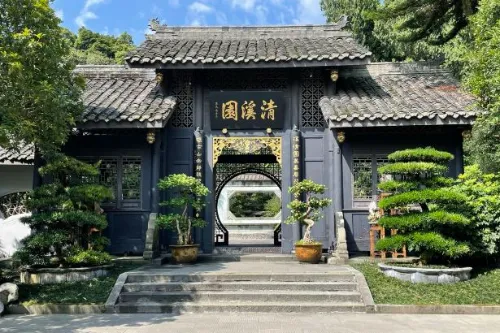
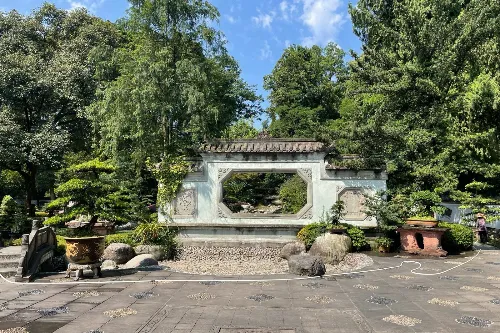
Yulei Pavilion
Situated at the top of Yulei Mountain in Dujiangyan Scenic Area, Yulei Pavilion has six above-ground floors and is the highest point of the scenic area. Climbing to the top, you can enjoy a panoramic view of the Dujiangyan Water Conservancy Project and the urban area—you can see the thousand-year-old ancient city to the east, the Chengdu Plain to the west, the source of the Minjiang River to the north, and the 800-li (about 400 kilometers) Qingcheng Mountain to the south.
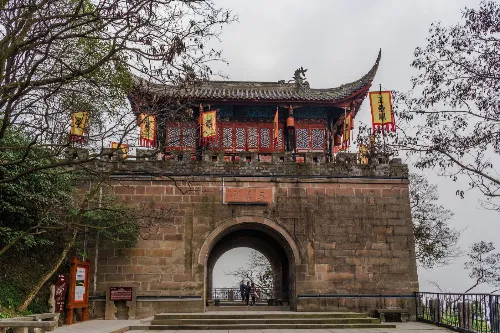
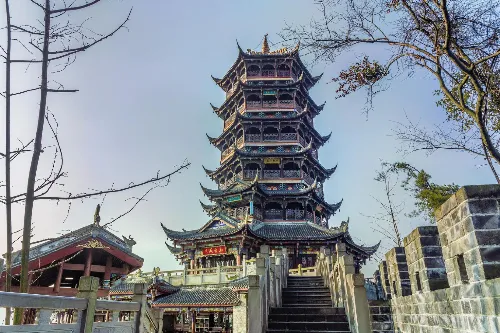
Chenghuang Temple (City God Temple)
Located on Yulei Mountain, Chenghuang Temple is an ancient temple for worshipping the City God. With a unique design style, the temple is built according to the mountain’s terrain and slope, featuring a rigorous and ingenious structure. Its architectural complex has been included in the teaching materials of Tsinghua University’s School of Architecture, holding high historical and archaeological value.
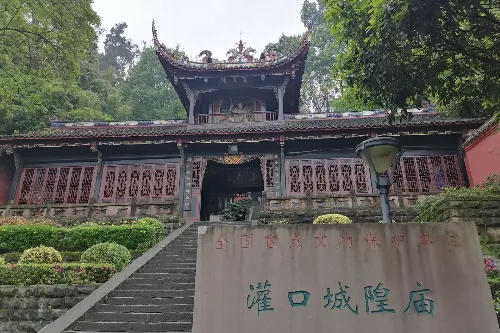
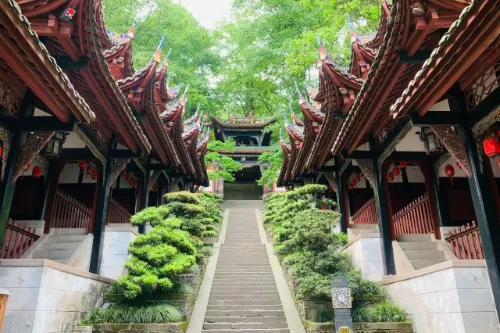
Tour Routes
Recommended Tour Route: Yangong Road → Fulongguan → Bottle-Neck Channel → Flying Sand Weir → Fish Mouth → Anlan Cable Bridge → Erwang Temple. This route allows visitors to fully understand the principles and history of the Dujiangyan Water Conservancy Project and appreciate the main attractions of the scenic area.
Travel Tips
- It is recommended to start early to avoid peak tourist hours, which allows for a better experience of the attractions.
- Wear comfortable shoes, as the scenic area involves a long walking distance.
- Consider hiring a tour guide to gain a deeper understanding of Dujiangyan’s historical culture and the principles of the water conservancy project.
- When visiting in summer, take sun protection and heatstroke prevention measures; in winter, keep warm.
Notes
- Abide by the scenic area regulations and do not arbitrarily damage cultural relics or scenic facilities.
- When walking on the Anlan Cable Bridge, pay attention to safety and do not chase, fight, or shake the bridge.
- Keep your personal belongings safe, especially in crowded areas.
- In case of bad weather, follow the arrangements of the scenic area staff and move to a safe place in a timely manner.
Transportation
- High-Speed Rail: Take the high-speed rail from Chengdu Xipu Station to Dujiangyan Station or Lidui Park Station. Lidui Park Station is closer to the scenic area, and it takes about 10 minutes to walk to the scenic area after exiting the station.
- Bus: Within Dujiangyan City, you can take Bus No. 4, 6, 7, 9, 10, etc., to reach Dujiangyan Scenic Area.
- Self-Driving: Depart from Chengdu and take the Chengdu-Dujiangyan Expressway to reach Dujiangyan Scenic Area. There is a parking lot in the scenic area.
Opening Hours
The opening hours are 8:00 - 18:00 in summer and 8:00 - 17:30 in winter (ticket sales for the day will be stopped from 17:00).
Tickets
The ticket price is 80 yuan per person.
You can search for the official WeChat public account of the scenic area "青城山都江堰" to get the latest updates or purchase tickets online.
Online Booking
Click here to jump to the Trip.com ticketing platform for ticket purchase.


